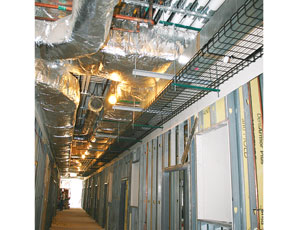One lesson learned from the Walsh Group’s construction- management assignment on a 650,000-sq-ft hospital in Elgin, Ill.—a project Walsh took over as mass excavation and steel procurement were under way—is that a lack of team experience with building information modeling should not be an inhibiting factor on a complex construction project.


Despite a rocky start and an opening scheduled for early 2010, Sherman Hospital is on time and on budget. “This is a BIM success story,” says Dan Klancnik, virtual construction manager for Chicago-based Walsh, who readily admits not all of them turn out that way. Success was achieved even though most of the individuals from Walsh and none of the subcontractors had BIM project experience, with the exception of BIM consultant Steven Cook from Kristine Fallon Associates Inc., Chicago. “For most of the people working for Walsh, it was their first BIM project,” Klancnik says.
Walsh picked up the job in the spring of 2007 when it was already under way. “The steel was ordered and construction had begun. We inherited several problems that we, hopefully, would not otherwise have had,” Klancnik says. “There was no owner initiative to do it as a BIM. That was our decision, based on the efficiencies BIM offered and because of the schedule difficulties we faced. We had to do it quickly and correctly.”
While firing up the BIM, Klancnik also found himself developing Walsh’s BIM policies and contract documentation, much of it during the most intense period of coordination, from August 2007 through February 2009. The documentation now includes up to eight pages of subcontractor conditions that were largely worked out through experience with Sherman Hospital. It specifies the level of detail, what is to be modeled, standards and naming conventions. “This document has everything but the kitchen sink because we know that anything that is modeled and coordinated is not going to be a problem,” Klancnik says.
The hospital, with a total project cost of $325 million, represented the kind of construction-coordination challenge BIM seems to be made for. But before getting to the construction coordination of subcontractor designs, the team had to correct alignment issues between the architectural and structural plans that were revealed as modeling from the 2D documents began, says Klancnik. He says the the issue was caught early enough to avoid major problems that could have arisen later on. “The point is, construction was moving full ahead when this was uncovered,” says Klancnik. “That single catch covered the couple-hundred-thousand- dollar overhead associated with BIM right there. [It] paid for the model creation.”
“It actually is a fairly common problem, but we usually catch it earlier because of the virtual models we construct,” says Cook, who now works for Walsh as health-care BIM manager. “That is one of the first things we look for when we build background models from 2D,” he says, adding, “When the architect and engineer produce construction documents with modeling software, that problem goes away.”
Coordination practices, particularly involving mechanical, electrical and plumbing trades, quickly evolved under pressure to launch the BIM. “How that MEP process looked at the beginning of our BIM adventure and how it looked toward the end are very different,” says Klancnik. “We decided it was easiest to collocate and get away from coordination sessions—get everyone in one room where they all had laptops. We tried overhead projectors, smart boards and all that stuff, and what we found was most effective was having everybody in the same room.
“The coordination schedule was accelerated, so they needed to be there fairly often. It was more beneficial for them to be able to talk about little problems,” says Cook. “It was my role to coordinate it. Early on, we tried to make it a formalized upload/review process and set hard dates, but it came to be upload-at-will. As they were done changing stuff, they would upload, and we would rerun the model. That meant the model was often out of date, but it was always getting updated.”
The fast pace and heavy demands led to another policy change, now incorporated into Walsh’s BIM protocols. Walsh reserves the right to assess the skills of BIM technicians that subs send to represent them on the team; if it finds them insufficiently skilled, it can tell the sub to replace them.
“We now ask for proof of competence and 3D modeling experience,” says Klancnik. “If someone cannot keep up, is inexperienced or unskilled with the technology, it is quickly obvious. Before the 3D process goes off now, we have a kick-off meeting and series of events where we discuss what we are going to do, how we are going to pull it off, what needs to happen to make it work, and talk about standards. It becomes obvious if their 3D modeling technician does not understand or doesn’t have the skill. In a 3D team-model process, the team is only as good as the slowest guy. If you have a weak link, it can really drag the process down. In the past we didn’t even know to ask.”
No Clashes
For clash detection, the modelers first started by comparing one sub’s entire model to another sub’s model. “We took the entire discipline of the HVAC ductwork against all the plumbing work and compared everything, says Cook. “But over time, we started dividing things out to categories, like primary ductwork versus secondary ductwork, so we could resolve the large runs—and once those were set, go after the smaller ones.” He says that approach was a more efficient use of subcontractors’ time.
virtual construction manager,
The Walsh Group, Chicago, Ill.
Cook says he also came to realize he was wasting his own time modeling supports and pads for medical equipment specified in the plans. The hospital owner wanted to install the latest equipment available at the time of commissioning, but it needed equipment specs to help the team develop cost estimates and schedule during years of planning. As a result, the equipment specified was not the equipment that actually would be installed. “There was a unistrut system in all of the operating rooms, but all of that changed once the equipment was actually chosen,” Cook says. “I spent a fair amount of time modeling that stuff, and then had to redo it once the equipment was selected.”
Klancnik says the team only modeled sequences and schedules for a few critical equipment moves and installations, and aside from clash detection, the “real bang for the buck” came from BIM’s enabling of offsite fabrication. “Even though we had all the space in the world, many of the trades fabricated offsite,” he says. “With the model, they were able to more accurately forecast site conditions and bring in larger sections at a time. It gives you a cleaner product and faster assembly. All of the big guys prefer to do that now,” he adds.
But one area where the team’s modeling efforts still needs improvement is in identifying where power sources such as low-voltage lines and lamp ballasts will need extra shielding to avoid inducing radio-frequency interference in data cables and electronic devices, Cook says. He says Autodesk’s NavisWorks, which the team already uses to provide access envelopes around devices that will need future maintenance, also can be used to map a manufacturer’s recommended clearance from power sources for RF-sensitive devices. Using that approach, the team should be able to anticipate and design shielding plans with confidence, he says.
“There are times where you get toward the end of a project and start turning on the lights and have to run around the building trying to figure out where this interference is coming from,” Cook says. “You wind up putting shielding on everything. It is kind of a pain.” He adds, “It is mainly in hospitals, just because of how much equipment is stuffed up above the ceilings.”




Post a comment to this article
Report Abusive Comment